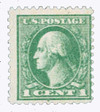
1918 1c Washington, gray green, double impression
# 525d - 1918 1c Washington, gray green, double impression
$35.00 - $55.00
U.S. #525d
1918-20 1¢ Washington
1918-20 1¢ Washington
Double Impression
Issue Date: December 1918
Printed by: Bureau of Engraving and Printing
Method: Offset printing
Watermark: None
Perforation: 11
Color: Grey green
The double impression on this stamp may have been caused by improper cleaning of the rubber cylinders used in producing offset stamps. U.S. #525 was printed on plates of 400 and 1600 subjects. The Series of 1918-1920 1¢ Washington stamps, including U.S. #525, all used the same design type. With the increase in postal rate during World War I, they often made up the new 3¢ rate when combined with common 2¢ stamps or on 2¢ stamped envelopes.
Offset Printing
The Bureau of Engraving and Printing experimented with a printing method known as “offset printing” to increase production and save money. Photographs of a die proof used for flat plate and rotary stamps were enlarged and “re-touched” to make the details clearer. A photo negative of the altered image was then shrunk back to stamp size and the image was imprinted repeatedly on a sensitized plate, one after the other. Next, an entire “mask” (image) of the plate was used to create the offset plates.
This allowed the bureau to create plates of much greater size than possible with the engraved method. Plates contained 400, 800, or 1600 stamp subjects.
Identifying Offset Printed Stamps
The ink on offset printed stamps feels smooth and flat. Stamps made by an engraved flat plate or rotary press have a textured feel, due to the raised ink on the surface. Offset printed stamps also often have poor-quality images. They typically don’t have as distinct detail as engraved stamps. Double-printed stamps were also relatively common. Sometimes sheets were so lightly printed they were run through again to save paper.
U.S. #525d
1918-20 1¢ Washington
1918-20 1¢ Washington
Double Impression
Issue Date: December 1918
Printed by: Bureau of Engraving and Printing
Method: Offset printing
Watermark: None
Perforation: 11
Color: Grey green
The double impression on this stamp may have been caused by improper cleaning of the rubber cylinders used in producing offset stamps. U.S. #525 was printed on plates of 400 and 1600 subjects. The Series of 1918-1920 1¢ Washington stamps, including U.S. #525, all used the same design type. With the increase in postal rate during World War I, they often made up the new 3¢ rate when combined with common 2¢ stamps or on 2¢ stamped envelopes.
Offset Printing
The Bureau of Engraving and Printing experimented with a printing method known as “offset printing” to increase production and save money. Photographs of a die proof used for flat plate and rotary stamps were enlarged and “re-touched” to make the details clearer. A photo negative of the altered image was then shrunk back to stamp size and the image was imprinted repeatedly on a sensitized plate, one after the other. Next, an entire “mask” (image) of the plate was used to create the offset plates.
This allowed the bureau to create plates of much greater size than possible with the engraved method. Plates contained 400, 800, or 1600 stamp subjects.
Identifying Offset Printed Stamps
The ink on offset printed stamps feels smooth and flat. Stamps made by an engraved flat plate or rotary press have a textured feel, due to the raised ink on the surface. Offset printed stamps also often have poor-quality images. They typically don’t have as distinct detail as engraved stamps. Double-printed stamps were also relatively common. Sometimes sheets were so lightly printed they were run through again to save paper.








